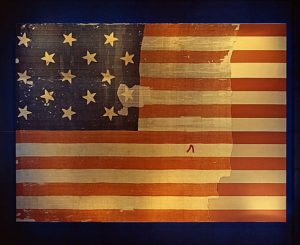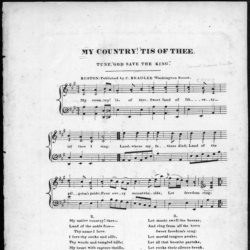| Source (English) | Translation (Hebrew) | Translation (Yiddish) |
|---|---|---|
O say, can you see, by the dawn’s early light, What so proudly we hailed at the twilight’s last gleaming, Whose broad stripes and bright stars, through the perilous fight, O’er the ramparts we watched were so gallantly streaming? And the rockets’ red glare, the bombs bursting in air Gave proof through the night that our flag was still there. O say, does that star-spangled banner yet wave O’er the land of the free and the home of the brave? |
הַגִּֽידוּ נָא, הֲתֶחֱזוּ לְאוֹר בֹּֽקֶר בּוֹקֵֽע, אֵת קִדָּֽמְנוּ בִּתְֿרוּעָה תְּמוֹל בֵּין עַרְבָּֽיִם, אֲשֶׁר פַּסָּיו וְכוֹכָבָיו בַּקְּֿרָב הַמְֿבַלֵּֽעַ, עַל הַחוֹמוֹת שָׁמַֽרְנוּ נִשְׁקְפוּ לָעֵינָֽיִם? וְכִידוֹדֵי אֵשׁ בָּרָמָה, וְרַֽעַם כְּלֵי מִלְחָמָה, הֵעִֽידוּ בַלָּֽיִל דִּגְלֵֽנוּ עוֹד שָֽׁמָּה; הַעוֹד דֶּֽגֶל הַכּוֹכָבִים, נֵס לַחוֹרִים, נוֹסֵס עַל אֶֽרֶץ הַדְּֿרוֹר וּבֵית הַגִּבּוֹרִים? |
אָ זאָג! קאָנסטו זען אין באַגינשײַן די פּראַכט פֿון געיוּבלטער פֿרײד אין פֿאַרנאַכטיקן בלױען? װי די שטרײַפֿן און שטערן אין גרױזאַמער שלאַכט אױפֿן פֿאָרט, העלדיש פֿלאַטערן נאָך מיט פֿאַרטרױען? רױטער שײַן פֿון ראַקעט, װאָס קאַנאָן שיסט אין לופֿט, אונדז באַװײַזט, אַז די פֿאָן נאָך צו העלדישקײט רופֿט! אָ זאָג! איז נאָך שטרײַפֿיקע פֿאָן אױסגעשפּרײט, איבער הײמען פֿון פֿרײַע און בראַװע צעװײט? |
On the shore dimly seen through the mists of the deep, Where the foe’s haughty host in dread silence reposes, What is that which the breeze, o’er the towering steep, As it fitfully blows, half conceals, half discloses? Now it catches the gleam of the morning’s first beam, In full glory reflected now shines in the stream: ‘Tis the star-spangled banner, O long may it wave O’er the land of the free and the home of the brave. |
עַל הַחוֹף הָנֶחְפָּא בְּאֵדֵי חַשְׁרַת מַֽיִם, חֵיל צַר יָהִיר שָׁם יַחֲנֶה בְּדוּמִיַּת אֵימָֽתָה, מֶה עַל הַר תָּלוּל זֶה רֹאשׁוֹ בַשָּׁמָֽיִם, חֶצְיֵֽהוּ תְגַלֶּה וְחֶצְיוֹ תַסְתִּיר סוּפָֽתָה? הִנֵּה זֶה עָֽתָּה, אוֹר הַבֹּֽקֶר עָטָה, וּמִיָּדוֹ קַרְנַֽיִם לַשִּׁבֹּֽלֶת מָטָה; זֶה דֶּֽגֶל הַכּוֹכָבִים! לָעַד לַדּוֹרִים, יִתְנוֹסֵס עַל אֶֽרֶץ הַדְּֿרוֹר בֵּית הַגִּבּוֹרִים. |
קאָנסט בײם ים־ברעג קױם זען, דורכן נעפּל פארשטעלט, אין דער אימהקער שטילקײט דעם שונא דאָרט ליגן; װאָם באװעגט זיך פון װינט איבער בערגלעך צעהעלט, גיט א װײ מיט אמאָל און עס װערט באלד אנטשװיגן? — ערשטער שײן פון באגינען צעגיסט זיך ארום, אין דעם שטראָם שפיגלען אָפּ זיך די שטראלן פון זון, און מען זעט: שטערן־שטרײפיקע פאָן אױסגעשפּרײט, איבער הײמען פון פרײע און בראװע צעװײט! |
And where is that band who so vauntingly swore That the havoc of war and the battle’s confusion, A home and a country, should leave us no more? Their blood has washed out their foul footsteps’ pollution. No refuge could save the hireling and slave From the terror of flight, or the gloom of the grave: And the star-spangled banner in triumph doth wave, O’er the land of the free and the home of the brave. |
וְאַיֵּה חֶֽבֶר זֵדִים בְּלִיַּֽעַל שָׁמִיר שַֽׁיִת, בְּאַפָּם נִשְׁבָּֽעוּ, שָׁאוֹן קָרְֿאוּ מִלֵּֽלוּ, אִם לָֽנוּ יַשְׁאִֽירוּ עוֹד אֶרֶץ וּבַֽיִת? דָמָם הֵן כִּפֵּר מְקוֹם רַגְלֵיהֶם חִלֵּֽלוּ, אָבַד וַיֵּאָסֶף מַנוֹס מִשְֹּֿכִירֵי כָּֽסֶף, נָעִים לִפְֿנֵי רוֹדֵף מִמָּֽוֶת אוֹרֵב כְּחָֽתֶף, וְדֶֽגֶל הַכּוכָבִים אוֹת עֹז עַם חוֹרִים, נוֹסֵס עַל אֶֽרֶץ הַדְּֿרוֹר וּבֵית הַגִּבּוֹרִים! | |
O thus be it ever, when freemen shall stand Between their loved homes and the war’s desolation. Blest with vict’ry and peace, may the Heav’n rescued land Praise the Power that hath made and preserved us a nation! Then conquer we must, when our cause it is just, And this be our motto: ‘In God is our trust.’ And the star-spangled banner in triumph shall wave O’er the land of the free and the home of the brave! |
כֵּן יִהְֿיֶה תָמִיד בְּנֵי חוֹרִין כִּי יַעֲמֽוֹדוּ, עַל נַפְשָׁם וּמְֿאוֹדָם וְעַל מוֹלֶֽדֶת אֶרֶץ, עַם נוֹשַׁע בֵּאלֹהִים חַסְדוֹ אָז יוֹדוּ, שֶׁהֶחְיָם וְקִיְּֿמָם וַיַּצִּילֵם מִקָּֽרֶץ. כִּי נָכוֹן עֶזְרֵֽנוּ יַֽעַן צֶֽדֶק דְּבָרֵנוּ, וּנְֿאֻמֵֽנוּ סֶֽלָה׃ שַׁדַּי יְהִי בְצָרֵֽנוּ! וְדֶֽגֶל הַכּוֹכָבִים לָעַד לְעַם חוֹרִים, יִתְנוֹסֵס עַל אֶֽרֶץ הַדְּֿרוֹר בֵּית הַגִּבּוֹרִים. |
פלאטער שטענדיק, װען מענטש מיטן שװערד אין זײן האנט װיל באשיצן זײן הײם קעגן שונאס פארגװאלטן; גאָט זאָל בענטשן מיט זיג און מיט פריד אונדזער לאנד, װאָס ער האָט אונדז ביז איצטער געהאָלפן צו האלטן. מיר גערעכטע, מיר װעלן די זיגער ארױס, װײל דער גלױבן אין גאָט גײט אונדז שטענדיק פאָראױס! שטערן־שטרײפיקע פאָן זאָל זײן זיגרײך צעשפּרײט, איבער הײמען פון פרײע און בראװע צעװײט! |
From the article “Fort McHenry” on Wikipedia:
During the War of 1812 an American storm flag, 17 by 25 feet (5.2 m × 7.6 m), was flown over Fort McHenry during the bombardment. It was replaced early on the morning of September 14, 1814 with a larger American garrison flag, 30 by 42 feet (9.1 m × 12.8 m). The larger flag signaled American victory over the British in the Battle of Baltimore. The sight of the ensign inspired Francis Scott Key to write the poem “Defence of Fort M’Henry” that was later set to the tune “To Anacreon in Heaven” and became known as “The Star Spangled Banner”, the national anthem of the United States.
Gershon Rosenzweig’s Hebrew translation of the poem, דֶגֶל הַכּוֹכָבִים (1898), is transcribed from that found in Joseph Magil’s 1903 collection of patriotic hymns, קֹֽבֶץ שִירֵי־צִיּוֹן וְשִׁירֵי־עָם, pp. 136-139.
This translation of three of the four of the anthem’s stanzas into Yiddish appears in the compilation of Berl Lapin’s work, Der fuler ḳrug lider-zamlung, 1908-1950 (1950). Some 20th century siddurim include the National Anthem (in its original English), including that of the Jewish Reconstructionist Foundation’s Sabbath Prayer Book (1945) and Rabbi Jacob Bosniak’s Prayers of Israel vol.1 for weekdays (1937). –Aharon Varady.
Source(s)




“The Star-Spangled Banner | די שטערן־שטרײפיקע פאָן | דֶגֶל הַכּוֹכָבִים — the national anthem of the United States by Francis Scott Key (1814)” is shared through the Open Siddur Project with a Creative Commons Public Domain Dedication 1.0 Universal license.



![Thanksgiving Day [1853] (Sabato Morais Ledger, p. 3, clipping 002) - c](https://opensiddur.org/wp-content/uploads/2022/07/Thanksgiving-Day-1853-Sabato-Morais-Ledger-p.-3-clipping-002-c-250x250.png)
![Thanksgiving Day [1856] (Sabato Morais Ledger, p. 8, clipping 007) - a](https://opensiddur.org/wp-content/uploads/2022/07/Thanksgiving-Day-1856-Sabato-Morais-Ledger-p.-8-clipping-007-a-250x250.jpg)





Leave a Reply